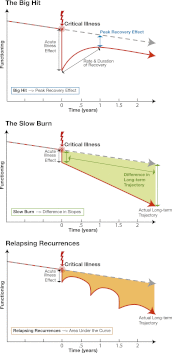Trajectories of recovery and dysfunction after acute illness, with implications for clinical trial design - PubMed (original) (raw)
Editorial
Trajectories of recovery and dysfunction after acute illness, with implications for clinical trial design
Theodore J Iwashyna. Am J Respir Crit Care Med. 2012.
No abstract available
Figures
Figure 1.
Prototypical trajectories of recovery. The upper gray line extending past critical illness is the counterfactual trajectory of functioning that would have occurred, had the patient not developed critical illness.
Comment on
- Predicting cognitive sequelae in survivors of critical illness with cognitive screening tests.
Woon FL, Dunn CB, Hopkins RO. Woon FL, et al. Am J Respir Crit Care Med. 2012 Aug 15;186(4):333-40. doi: 10.1164/rccm.201112-2261OC. Epub 2012 Jun 14. Am J Respir Crit Care Med. 2012. PMID: 22700858
Similar articles
- Predicting cognitive sequelae in survivors of critical illness with cognitive screening tests.
Woon FL, Dunn CB, Hopkins RO. Woon FL, et al. Am J Respir Crit Care Med. 2012 Aug 15;186(4):333-40. doi: 10.1164/rccm.201112-2261OC. Epub 2012 Jun 14. Am J Respir Crit Care Med. 2012. PMID: 22700858 - Prolonged cognitive dysfunction in survivors of critical illness.
Sukantarat KT, Burgess PW, Williamson RC, Brett SJ. Sukantarat KT, et al. Anaesthesia. 2005 Sep;60(9):847-53. doi: 10.1111/j.1365-2044.2005.04148.x. Anaesthesia. 2005. PMID: 16115244 - DIVERGT screening procedure predicts general cognitive functioning in adult long-term survivors of pediatric acute lymphoblastic leukemia: A PETALE study.
Boulet-Craig A, Robaey P, Laniel J, Bertout L, Drouin S, Krajinovic M, Laverdière C, Sinnett D, Sultan S, Lippé S. Boulet-Craig A, et al. Pediatr Blood Cancer. 2018 Sep;65(9):e27259. doi: 10.1002/pbc.27259. Epub 2018 May 24. Pediatr Blood Cancer. 2018. PMID: 29797640 - Cognitive dysfunction in intensive care survivors.
Chapman RJ, Brett SJ. Chapman RJ, et al. Br J Hosp Med (Lond). 2007 Sep;68(9):467-9. doi: 10.12968/hmed.2007.68.9.27164. Br J Hosp Med (Lond). 2007. PMID: 17953294 Review. - Long-term outcomes after critical illness.
Herridge MS. Herridge MS. Curr Opin Crit Care. 2002 Aug;8(4):331-6. doi: 10.1097/00075198-200208000-00010. Curr Opin Crit Care. 2002. PMID: 12386494 Review.
Cited by
- Ideal Postdischarge Follow-Up After Severe Pneumonia or Acute Respiratory Failure: A Qualitative Study of Primary Care Clinicians in Diverse Settings.
Hauschildt KE, Taylor SP, Hough CL, Hladek MD, Perrin EM, Iwashyna TJ. Hauschildt KE, et al. CHEST Crit Care. 2024 Sep;2(3):100079. doi: 10.1016/j.chstcc.2024.100079. Epub 2024 May 9. CHEST Crit Care. 2024. PMID: 39329025 Free PMC article. - Relationship of Age And Mobility Levels During Physical Rehabilitation With Clinical Outcomes in Critical Illness.
Mayer KP, Silva S, Beaty A, Davenport A, Minniti M, Dorn SU, White LS, Sabol VK, Pastva AM. Mayer KP, et al. Arch Rehabil Res Clin Transl. 2023 Oct 10;5(4):100305. doi: 10.1016/j.arrct.2023.100305. eCollection 2023 Dec. Arch Rehabil Res Clin Transl. 2023. PMID: 38163032 Free PMC article. - Do critical illness survivors with multimorbidity need a different model of care?
Stewart J, Bradley J, Smith S, McPeake J, Walsh T, Haines K, Leggett N, Hart N, McAuley D. Stewart J, et al. Crit Care. 2023 Dec 8;27(1):485. doi: 10.1186/s13054-023-04770-6. Crit Care. 2023. PMID: 38066562 Free PMC article. Review. - The impact of high versus standard enteral protein provision on functional recovery following intensive care admission (PRECISE trial): study protocol for a randomized controlled, quadruple blinded, multicenter, parallel group trial in mechanically ventilated patients.
van Gassel RJJ, Bels JLM, Tartaglia K, van Bussel BCT, van Kuijk SMJ, Deane AM, Puthucheary Z, Weijs PJM, Vloet L, Beishuizen B, De Bie Dekker A, Fraipont V, Lamote S, Ledoux D, Scheeren C, De Waele E, van Zanten ARH, Mesotten D, van de Poll MCG. van Gassel RJJ, et al. Trials. 2023 Jun 19;24(1):416. doi: 10.1186/s13063-023-07380-3. Trials. 2023. PMID: 37337234 Free PMC article. - Quantifying Physical Resilience in Ageing Using Measurement Instruments: A Scoping Review.
Peters S, Cosco TD, Mackey DC, Sarohia GS, Leong J, Wister A. Peters S, et al. Physiother Can. 2022 Apr 7;74(4):370-378. doi: 10.3138/ptc-2020-0134. eCollection 2022 Nov. Physiother Can. 2022. PMID: 37324610 Free PMC article.
References
- Needham DM, Davidson J, Cohen H, Hopkins RO, Weinert C, Wunsch H, Zawistowski C, Bemis-Dougherty A, Berney SC, Bienvenu OJ, et al. Improving long-term outcomes after discharge from intensive care unit: report from a stakeholders’ conference. Crit Care Med 2012;40:502–509 - PubMed
- Woon FL, Dunn CB, Hopkins RO. Predicting cognitive sequelae in survivors of critical illness with cognitive screening tests. Am J Respir Crit Care Med 2012;186:333–340 - PubMed
Publication types
MeSH terms
LinkOut - more resources
Full Text Sources
